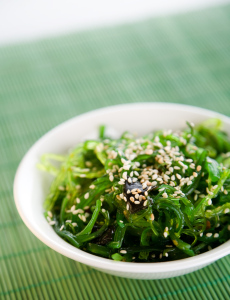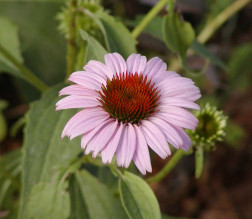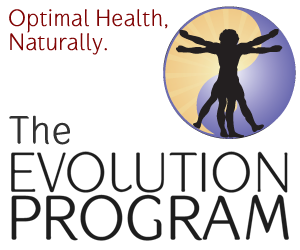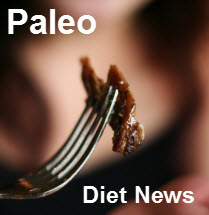The Paleo Diet and Superfoods – Part 3: Seaweed and Herbs
 This third article in the Paleo diet and superfoods series (you can read part one here and part two here) is all about seaweed and herbs, two powerful sources of nutrition and healing. Both plant sources have a long history of use for humans, going back, certainly tens of thousands of years and probably much longer.
This third article in the Paleo diet and superfoods series (you can read part one here and part two here) is all about seaweed and herbs, two powerful sources of nutrition and healing. Both plant sources have a long history of use for humans, going back, certainly tens of thousands of years and probably much longer.
Seaweed or sea vegetables have the broadest range of minerals of any food and are an excellent source of B-vitamin folate, and magnesium, as well as a great source of iron, calcium, and the B-vitamins riboflavin and pantothenic acid. It seems that our Paleo ancestors also knew the value of sea vegetables. We know through archeological evidence that at Monte Verde in Southern Chile, humans have harvested and preserved seaweed and used seaweeds for food and medicinal purposes for upwards of 20,000 years.
Herbs also have a long history with humans too. A Neanderthal burial site in Iraq, which dates back 60,000, had large amounts of pollen from plants that are known to be medicinal. We would all do well to include herbs and sea vegetables in our diets on a regular basis.
Seaweed
Seaweed is one of the, if not the most nutritionally dense plant food source on earth. This is because they have access to all the nutrients found in the ocean. Seaweeds are exceptionally high in calcium, higher than milk or beef. In addition, it contains significant amounts of lignans, which are plant compounds with cancer-protective properties. And they have even more interesting properties. From Foodmatters.tv:

Kelp. Photo by Stef Maruch. Image courtesy of Wikipedia.org
…. The chemical composition of seaweeds is so close to human blood plasma, that perhaps their greatest benefit is regulating and purifying our blood system. They help to alkalize our blood, neutralizing the over-acid effects of our modern diet and protect us from a wide array of toxic elements in the environment, including heavy metals, pollutants and radiation by-products converting them to harmless salts that the body can eliminate.
But the most remarkable results with seaweeds we see is boosting weight loss and deterring cellulite build-up. The high concentration of natural iodine helps to stimulate the thyroid gland so that food fuels are used before they can be turned into fatty deposits. At the same time, the minerals act like electrolytes to break the chemical bond that seals the fat cells allowing trapped wastes to escape. Both by eating sea vegetables or bathing in them helps reduce cellulite and stimulates lymphatic drainage.
I love doing research for this site. I learn something new everyday. Seaweed is close in composition to human blood plasma? That is fascinating. And that it stimulates lymphatic drainage is personally important to me, since my lymph system is so bogged down. It’s time for me to increase my seaweed intake!
There are several different types of seaweed. All of these are delicious and beneficial:
Nori - is best known for the seaweed used to make sushi rolls. You can make your own at home, make sure you use the untoasted nori sheets for maximum nutrient content.
Kelp - kelp is available in powder or capsule form for those who feel awkward eating seaweed. It is also the most common seaweed found along the ocean shores. Due to their thick leaves they are perfect for a hot seaweed bath.
Dulse - a red seaweed, available in flakes. There is no need to cook dulse. It is great to use as seasoning on salads, vegetables and soups.
Arame - consists of brown stringy seaweed. Soak in hot water for 5 minutes and it is ready to use.
Wakame - With a sweet flavor makes a great compliment to sandwiches. Soak for 5 minutes in hot water.
Kombu - Used in Japan for centuries as a mineral rich flavour enhancer. Add a strip of kombu when cooking beans making them more digestible and reducing gas. Add a strip of kombu to your sprouts when soaking them to allow them to soak up the minerals.
Since the benefits from eating sea vegetables is so huge it makes sense to include them into your diet every day. And seaweed is definitely a Paleo diet yes!
Herbs

''Echinacea purpurea'' (purple coneflower). Photo by Stan Shebs, image courtesy of Wikipedia.org
The medicinal use of herbs has been going on for a very long time It is most likely that our Paleo ancestors would have used herbs as medicines and as seasonings. Preparation of herbs for medicinal use, would probably have included teas, poultices, infusions and through burning, for the resultant smoke.Herbs are best used in their whole form since isolating the “active ingredient” may limit the herb’s efficacy. From Foodmatters.tv:
Herbs as nourishment offer the body a whole host of nutrients it may not have received either because of poor diet or environmental deficiencies in the soil or air. Herbs as medicine are essentially body balancers that work with the body functions so that it can heal and regulate itself. Herbs have been used for centuries as part of the wisdoms of natural healing methods…….. Since all body parts and most disease symptoms are interrelated, it is wise to use herbs which can affect each part of the problem.
There are hundreds of medicinal herbs, far too many to list here. Below is a list of the most commonly used and best generally known:
Nettle - the bowel mover. These plants are best known as stinging nettle plants. However when the nettle leaves are dried and eaten the saliva neutralizes the sting. Nettles are incredibly effective in removing unwanted pounds. A cup of nettle tea in the morning is ideal to get things going in the bowel department. The nettle leaves increase the thyroid function, increase metabolism and releases mucus in the colon allowing for the flushing of excess wastes.
Aloe vera - Aloe vera is a perennial succulent that grows in a wild and seems to do best in tropical and sub-tropical areas. It has been deemed a superfood after research studies identifying its seventy-five healing compounds including natural steroids, antibiotic agents, amino acids, minerals and enzymes. Aloe vera has been used since Egyptian times as a skin moisturizer, and healer for burns, cuts, bruises, acne and eczema. This is mostly due to the high concentration of natural sulphur (MSM) that it contains. Aloe juices alkalizes the digestive tract preventing over-acidity, a common cause of indigestion, acid reflux, heartburn and ulcers.
Echinacea - Echinacea is a household name when it comes to warding off colds and flu. This herb is used as a natural antibiotic and immune system stimulator, helping to build up resistance. The reason for its effectiveness is because of its ability to stimulate the lymph flow in the body. Lymph runs parallel with our bloodstream and carries toxins out of the body. The herb can be taken in liquid or capsule form for 2-3 week periods during “high risk” flu seasons. The tea from this herb has also grown in popularity for treating infections and cancers including skin cancer.
Ginseng - Ginseng is the quintessential herb for handling stress. This ancient healing herb has been used widely throughout Asia as an energizer tonic. This special herb is particularly beneficial when recovering from illness or surgery for its restorative and anti-infection properties. It promotes regeneration from stress and fatigue.
The great thing about herbs is that if you have a little bit of space in a mostly sunny spot you can grow some of these on your own. I have echinacea growing wild in my yard and I ALWAYS have aloe vera on hand for burns and cuts. And I drink echinacea tea to stimulate the lymph system.
The Paleo Diet and Superfoods - Seaweed Recipe!
This recipe for Wasabi-Toasted Nori Crisps comes to us from The Kitchn (no, that’s not a misspelling). While the site is not paleo, this recipe is, so enjoy!
Wasabi-Toasted Nori Crisps
Makes about 60 crisps
- 1/4 cup water
- 2 tablespoons powdered horseradish wasabi
- 10 sheets nori
- salt
Heat oven to 250°F.
Combine the water and the wasabi in a small bowl and whisk with a fork until the wasabi is dissolved. The wasabi tends to settle to the bottom, so you may need to re-whisk between batches.
Take one sheet of nori and fold it in half. Unfold it and lightly paint half the sheet with the wasabi water using a pastry brush. Sprinkle the inside with salt and press it closed. Lightly brush the top with wasabi water, as well (but do not salt). Using a sharp knife, cut the nori into six strips and transfer them to a baking sheet.
Repeat this process with each sheet of nori until you have filled the baking sheet. Strips can be close to each other, but should
be in a single layer without touching. Bake for 10-13 minutes, until darkened, dry to the touch, and brittle. Transfer the nori crisps to a cooling rack to finish crisping. Repeat with any remaining sheets of nori.
You might not believe us now, but it’s incredibly easy to eat this entire batch in a single sitting, with or without help! If you do happen to have any leftovers, store them in an airtight container. They will stale a bit with time, but should still stay crispy for a few days.
There is more to come in this series of the Paleo diet and superfoods, so stay tuned!
Have you added any superfood seaweeds and herbs to your Paleo diet? Have you noticed any improvements as a result? Please share them below with other readers. And if you enjoyed this article, please share it with your friends and family on Facebook and Twitter. Thank you!






Thank you for this Lila!!
I have been so curious about seaweed.
So…thoughts on picking it up off the beach?
Since you live in Australia, you might be safe eating seaweed from the beach, but you would want to check that out to be certain. Here in the US, I probably wouldn’t but it might also depend where in the US that someone lives. Some areas are highly polluted.
Thanks for commenting Crystal!